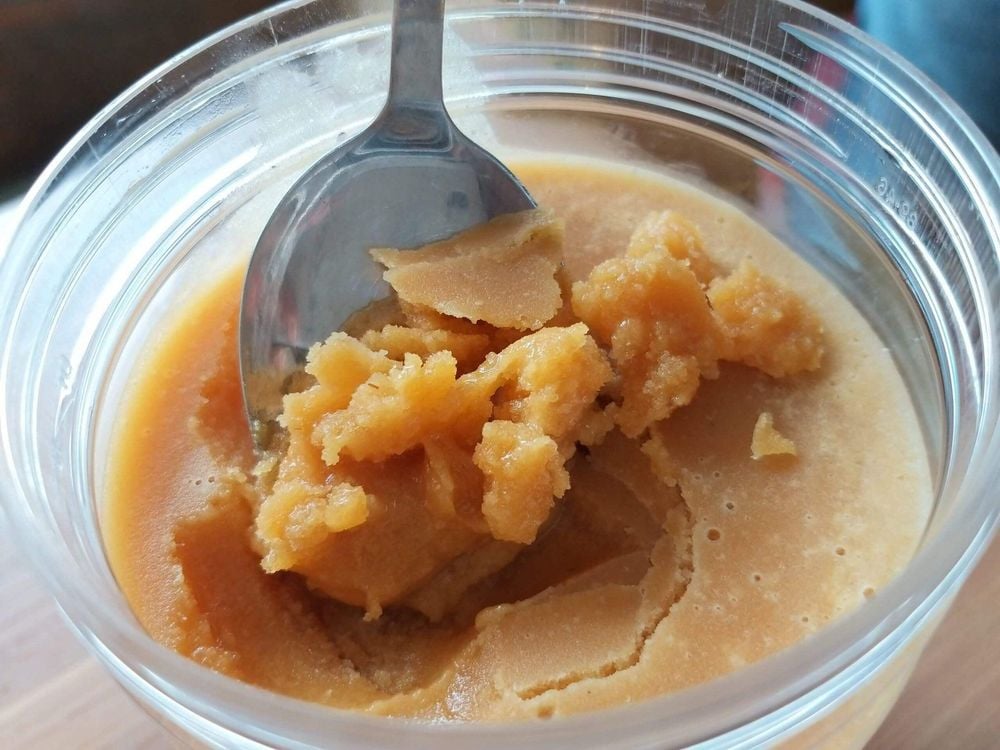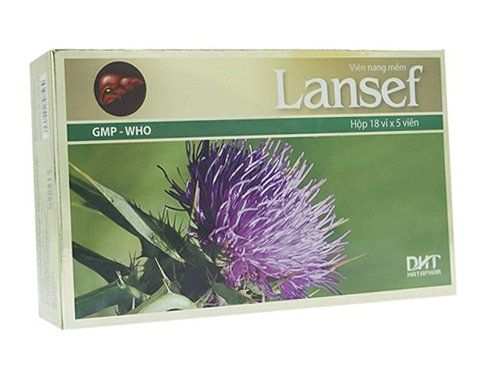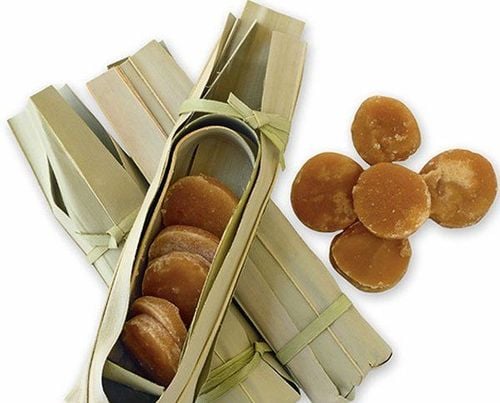This is an automatically translated article.
Palm sugar is the most commonly used sweetener in every household. Sugar comes in the form of white, translucent crystals while jaggery can range in color from golden brown to dark brown. However, many nutritionists today recommend replacing sugar with jaggery.1. What is palm sugar?
Palm sugar is a sweetener that is gaining popularity. This is an unrefined sugar product produced in Asia and Africa. Palm sugar is sometimes called "non-centrifugal sugar," because it is not spun during processing to remove the nutritious molasses.Similar non-centrifugal sugar products exist throughout Asia, Latin America and the Caribbean, although they all have different names.
These products include:
Gur: India. Panela: Colombia. Piloncillo: Mexico. Tapa dulce: Costa Rica. Namtan tanode: Thailand. Gula Melaka: Malaysia. Kokuto: Japan. About 70% of the world's palm sugar production is in India, where it is commonly known as "gur".
2. How is palm sugar made?
Palm sugar is made by traditional method of pressing and distilled juice from palm or sugar cane:Step 1: Extraction - The sugar cane or palm tree is pressed to get fresh juice or sap. Step 2: Clarification - The juice is left in large buckets so that the sediment settles to the bottom. It is then strained to produce a transparent liquid. Step 3: Concentrate - The juice is put in a very large, flat-bottomed saucepan and brought to a boil. In this process, jaggery is stirred and impurities are skimmed off the top until only a yellow paste remains. This “dough” is then transferred to a mold or container, where it cools into jaggery.
Color can range from light yellow to dark brown. This is important, as color and texture are used to classify jaggery. Interestingly, Indians value lighter colors more than darker colors.
This lighter, “good quality” jaggery typically contains more than 70% sucrose. It also contains less than 10% glucose and fructose isolate, with 5% being minerals. It is usually sold as a solid sugar block, but it is also produced in liquid and granular form.

Đường thốt nốt là chất làm ngọt được sử dụng phổ biến
3. Nutritional information of palm sugar
Palm sugar contains more nutrients than refined sugar because it contains molasses. Molasses is a nutritious by-product of sugar production, usually removed when making refined sugar.Includes added molasses with a small amount of micronutrients to the final product. The exact nutritional composition of this sweetener can vary, depending on the plant used to make it (cane or palm).
According to one source, 100 grams (half cup) of jaggery can contain:
Calories: 383. Sucrose : 65–85 grams. Fructose and glucose: 10–15 grams. Protein: 0.4 grams. Fat: 0.1 grams. Iron: 11 mg, or 61% of the RDI. Magnesium: 70-90 mg, or about 20% of the RDI. Potassium: 1050 mg, or 30% of the RDI. Manganese: 0.2–0.5 mg, or 10–20% of the RDI. However, keep in mind that this is a 100 gram (3.5 oz) serving, which is much more than you would normally eat all at once. You will probably consume close to a tablespoon (20 grams) or a teaspoon (7 grams).
Palm sugar may also contain small amounts of B vitamins and minerals, including calcium, zinc, phosphorus and copper. A commercially available product, Sugar Vida, is granulated jaggery that is said to be a good source of natural B vitamins.
Palm sugar is an excellent source of iron for plant products. One serving can contain almost 10% of your iron needs for the day. Iron is important for supporting healthy blood cells. Getting enough iron in your diet can help you feel less tired and improve muscle function.
4. What can palm sugar be used for?
Like sugar, jaggery is very versatile. It can be ground or broken down, then used as a substitute for refined sugar in any food or drink.In India, it is often mixed with foods, such as coconut, peanuts and condensed milk to make traditional desserts and sweets. These include jaggery cakes and chakkara pongal, a dessert made with rice and milk. It is also used to make traditional alcoholic beverages, such as palm wine, and for non-food purposes such as dyed fabrics.
In the Western world, this sweetener is often used as a sugar substitute in baking. It can also be used to sweeten beverages such as tea and coffee. Today, palm sugar is very popular and can be purchased at the grocery store or at the market.

Đường thốt nốt chứa nhiều chất dinh dưỡng hơn đường tinh luyện
5. Potential Health Benefits of Palm Sugar
Palm sugar contains more vitamins and minerals than many other sweeteners. Research has uncovered several potential health benefits of eating jaggery:Prevents anemia One of the most common nutrient deficiencies in the US is iron deficiency. Iron is necessary for the formation of healthy blood and muscle cells. If you don't get enough iron in your diet, you can develop iron-deficiency anemia, have trouble concentrating, and can cause fatigue and muscle weakness.
Palm sugar is an excellent plant source of iron. Although one serving of jaggery is not enough to meet your daily iron requirement, replacing refined sugar with jaggery will add more iron to your diet and help reduce your risk of developing the disease. anemia.
Palm sugar contains about 11 mg of iron per 100 grams, or about 61% of the RDI. This sounds impressive, but it is unlikely that you will eat all of 100 grams of jaggery in one go. A tablespoon or teaspoon will represent a more realistic portion.
One tablespoon (20 grams) contains 2.2 mg of iron (about 12% of the RDI). One teaspoon (7 grams) contains 0.77 mg of iron (about 4% of the RDI). For those with low iron, jaggery can contribute with a small amount of iron - especially when replacing white sugar. Some studies also show that the iron in jaggery is more easily absorbed by the body than other plant-based irons. For people who choose a plant-based diet, jaggery can help them increase their iron levels without the need for additional supplements.
Improve Digestive Health In India, it is common to use jaggery after meals. Some people claim that it helps with digestion and can stimulate bowel movements, preventing constipation.
Palm sugar is a good source of sucrose, but it contains almost no fiber or water (two dietary factors known to help regular bowel movements). There are no studies to confirm this claim. In terms of nutritional composition, it seems that jaggery helps with digestion or prevents constipation.
Liver Detox Many foods are said to help detoxify the liver. However, your body is capable of getting rid of these toxins on its own.
Improves Immune Function In India, jaggery will often be added to tonics used to treat a variety of ailments. It is believed that the minerals and antioxidants in jaggery can support the immune system, helping people recover from illnesses such as the common cold and flu.
Compared to other sweeteners, jaggery is a rich source of antioxidants. Palm molasses contains phenolic acids that help reduce oxidative stress in the body. Antioxidants in general have been linked to a reduced risk of certain forms of cancer, reduced signs of aging, and a reduced risk of dementia and macular degeneration. Therefore, switching from white or brown sugar to jaggery may help reduce the risk of developing these conditions.
Palm sugar for strong bones Palm sugar provides essential nutrients for healthy bones and tissues of children such as minerals, calcium, and phosphorus.

Sử dụng đường thốt nốt giúp xương chắc khỏe
6. Potential risks of palm sugar
Although it has more nutrients than many other sugars, these benefits may not outweigh the risks of consuming jaggery for people with certain health conditions. You should consult your doctor before increasing your jaggery intake significantly.Consider the following health risks before eating large amounts of jaggery:
Raise blood sugar Like all other forms of sugar, jaggery is primarily sucrose. While it is less advanced than other sweeteners, it still has a significant impact on blood sugar levels. For those who need to reduce their sugar intake, jaggery is not a safer alternative.
In particular, people with diabetes will notice almost identical effects on their insulin levels after consuming jaggery. Consuming too much jaggery increases fasting insulin just as effectively as other sugars, so people with diabetes should consult their doctor before adding jaggery to their diet. his eating.
May increase obesity risk Palm sugar is a slightly more nutritious form of sugar, but it's still sugar. Consuming a significant amount of sugar is associated with an increased risk of obesity. While sugar has yet to be proven to cause overweight or obesity, there's no denying that consuming significant amounts of added sugars is linked to this medical condition.
Intestinal upset Palm sugar is less processed than most forms of sugar. For most people, it's completely safe to eat. However, for some people, this lower processing threshold can cause intestinal problems. Some forms of jaggery, especially homemade jaggery, can carry bacteria and lead to food poisoning. To reduce this risk, it is best to avoid homemade jaggery and consume only jaggery made by commercial manufacturers.
Please dial HOTLINE for more information or register for an appointment HERE. Download MyVinmec app to make appointments faster and to manage your bookings easily.
Reference sources: healthline.com, webmd.com












